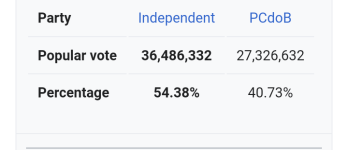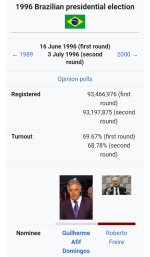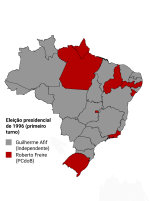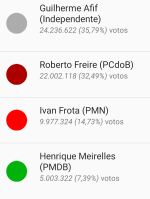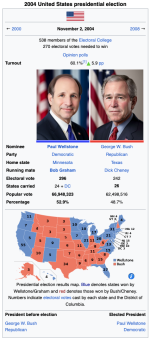-
Hi Guest!
The costs of running this forum are covered by Sea Lion Press. If you'd like to help support the company and the forum, visit patreon.com/sealionpress
You are using an out of date browser. It may not display this or other websites correctly.
You should upgrade or use an alternative browser.
You should upgrade or use an alternative browser.
Alternate Wikibox Thread
- Thread starter gentleman biaggi
- Start date
Meppo
Anticommunist Mole
- Location
- Default City, Russia
- Pronouns
- he/him
Surprised there aren't more parties in government, the Cadets must have a lot of seats
Who's in the opposition anyhow?
NotDavidSoslan
Active member
Still ironing everything out, but there's a broadly national-conservative party (who are the official opposition); the long-suffering socialists, who are still reeling from a violent split from when the progressive Left Alliance broke off from the very much "old left" Socialist Labour Party; the Pirate Party has a handful of seats; there are probably a few localist/regionalist/minority interest parties (which I've yet to work out); and there's the new right-libertarian party led by populist firebrand Roman Baber.Surprised there aren't more parties in government, the Cadets must have a lot of seats
Who's in the opposition anyhow?
BigVic_1994
New member
Rule by decreeYouGov calls it right (with its latest poll)...

Meppo
Anticommunist Mole
- Location
- Default City, Russia
- Pronouns
- he/him
Huh. Thought the *CPRF candidate would have won more states and be less centered in Rio de Janeiro and São Paulo — though that explains the popular vote, I suppose?Brazil with Russian politics: 1996 presidential election (in the wrong order due to a spacing glitch)
View attachment 81844
View attachment 81843
View attachment 81842
View attachment 81841
NotDavidSoslan
Active member
I used the Brazilian coalitions at the time - the Northeast only shifted to the left after Lula was elected.Huh. Thought the *CPRF candidate would have won more states and be less centered in Rio de Janeiro and São Paulo — though that explains the popular vote, I suppose?
Meppo
Anticommunist Mole
- Location
- Default City, Russia
- Pronouns
- he/him
I used the Brazilian coalitions at the time - the Northeast only shifted to the left after Lula was elected.
wilcoxchar
Well-known member
- Pronouns
- he/him
Next up, Montana.

Turner Bison SC is one of the clubs owned by Ted Turner. He owns a few clubs in various states and at least one more will come up in a later box.
I did consider not splitting the Montana league and maybe having it be on a summer schedule or something, but with doing these state by state like this I don't really want to try and figure out the the logistics of that with the American Championship when I get to it. So Montana has to deal with a winter (or more likely spring) schedule, and this way there's a little bit more interesting variation in the league structures.
KolyenuKS
Active member
- Location
- Kansas (unfortunately)
CTTeller
You still haven't passed my pipe
- Location
- Pinner, Middlesex
- Pronouns
- he/him
BigVic_1994
New member
How do you make Wikiboxes for SLP and AH.com
Last time this question has come up I answered with this, I think it’s essentially right:How do you make Wikiboxes for SLP and AH.com
I’ve heard the Wikipedia policy against making wikiboxes is ill-enforced, so you can try your luck. Additionally, if you want to edit wikiboxes in a quick and simple way, do inspect element then take screenshots.The most typical way to make wikiboxes has been to, first, make an account on wikipedia, copy-and-paste a wikibox from a wikipedia page into your personal account sandbox, and then edit the stuff in it to what you want. You'd also need to (if you're making wikiboxes with a map or diagram) install Inkscape into your machine, download the SVG file you want to change, edit it using Inkscape, upload it to Wikimedia Commons, and then put it in your wikibox. However, I recommend you do not do this, as wikipedia has a policy against this now. I am not sure how enforced it is, but I would not try my luck.
You can use this site instead for making your wikibox - you just follow the steps I've outlined above but, instead of using a Wikipedia sandbox you use this site's sandbox, and you upload your images to it.
The way I prefer to make wikiboxes is by using mock templates I have made on Inkscape by tracing screenshots of wikiboxes. Here's an entire folder of various templates, though as I know it's messy here is a template for US presidential elections. It's also not too hard to trace wikibox screenshots yourself.
Also, before you take wikibox screenshots, I suggest opening the page in incognito mode to get rid of purple links. Furthermore, to add in custom photos or diagrams to wikibox screenshots, put a placeholder in your wikibox itself, and then in the screenshot combination stage paste them on top of the wikibox, rather than uploading something to wikimedia commons.
Blackentheborg
Dennis Skinner's molotov
- Location
- Grand Hotel Abyss
- Pronouns
- He/Him
Erinthecute
Well-known member
- Location
- Australia
- Pronouns
- she/her
Great infobox but that Wellstone picture feels very uncanny valley
shearsforest
The Authentic Shears
- Location
- Test Domain
- Pronouns
- he/him
So is the Bush photo.Great infobox but that Wellstone picture feels very uncanny valley
frustrated progressive
SLPing Through the Cracks
For a sec I honestly thought both of them were AI-generated composites.So is the Bush photo.
2ndH00PTIE$ON
Member
Aren’t they? They have that glossy look that’s in alot of AI art.For a sec I honestly thought both of them were AI-generated composites.
DivergentHistory.comOregon is a state that’s very confusing to those both politically and in general for many Americans. In between two very financially successful, very liberal states (Washington and California), many wonder how Oregon, a naturally beautiful state, has managed to avoid both fates. Oregon is now a staunchly Republican state, with a dying out state Democratic party, something that was completely inconceivable even 25 years ago.
Oregon’s reign of Democratic dominance largely began in the late 1950s. Long considered one of the more Republican states in the nation, the party change of senator Wayne Morse after the selection of Richard Nixon in 1952, and later the election of Richard Nueberger in 1954, had allowed the state to move more towards The Democracy. However, when the Democratic party nominated a ticket of John F. Kennedy and Henry M. “Scoop” Jackson, the state was largely expected to vote against it, despite a regional favorite son being on the ticket, largely due to the large protestant makeup of the state and Portland mayor Terry Schrunk’s personal beef with the Kennedys.
1960 United States Presidential Election in Oregon:
John F. Kennedy / Henry M. Jackson (Democratic) - 50.2%
Richard Nixon / Henry Cabot Lodge II (Republican) - 49.6%
However, as the campaign wore on, Kennedy’s popularity in the state grew, and a home region effect from Scoop Jackson would pull the state towards Kennedy. However, Schrunk’s influence would be felt, as Multnomah county, home to Portland, would vote against a Democrat for the last time for 50 years.
In Oregon’s senate election that year, the race focused around former senator Richard Neuberger - who had died of testicular cancer. Although Neuberger’s widow, Maurine, herself a state senator, was the front-runner, her own cancer scare caused her to decide against running - which led to a surprising choice for the Democrats. Harry Bovin, a conservative Democrat and state senator from Medford, would shock the state by winning the Democratic primary. Bovin’s victory was seen as a success for the rural conservative areas of the state, and against Elmo Smith, a relatively unpopular ex-governor, he dominated the rural areas and won just enough of Portland to pull off a win.
Bovin would serve as Oregons senator until his death in 1999 at 92 years old, doing so as Senate Pro Tempore and being recognized as a master legislator who would serve as senate majority leader in the 1970s and 1980s.
In 1962, Oregon’s “boy governor” Mark Hatfield, a popular moderate Republican, would run for senate against incumbent Wayne Morse, giving up the governor’s mansion. Hatfield’s campaign against the radical liberal senator carried a lot of weight, especially as many Democrats had grown tired of Morse’s antics in the senate. Indeed, it was said that even the Kennedy White House was “silently rooting” for Morse, a thorn in their side from the left, to be replaced with Hatfield, who really wasn’t that much different from any other Democrat on most issues. For most of the campaign, Hatfield led Morse, and many Democrats were considering “punting” the race away for 1968.
However, two events saved Morse. The first was the peaceful ending of the Cuban Missile Crisis, which boosted all Democrats in a Kennedy midterm. The second was the shocking assassination of president Kennedy, only 13 days before the midterm. Kennedy was killed by known anti-Catholic Richard Pavlick, an incident which began president Henry Jackson’s “War on Hate”. Morse, despite having run against Kennedy in 1960, gave a speech memorializing the former president and, after President Jackson did the same, called to support Kennedy’s civil rights bill. Morse would narrowly defeat Hatfield as Democrats swept the senate.
1962 United States senate election in Oregon
Wayne Morse (Democratic-inc.) - 51.4%
Mark Hatfield (Republican) - 47.7%
Morse’s narrow victory would be the closest of his remaining career, holding onto the seat for decades until his loss in 1980 due to a statewide “Republican Revolution”. Gubernatorially, Haftfield’s hand-chosen successor, Howell Appling Jr., would be defeated in a much less close race by Attorney General Robert Y. Thornton.
Six years later, and the United States looked much different than it had in 1962. Henry M. Jackson used massive victories - both in 1962 and in 1964 - to pass civil rights bills, and formed the “Fair Society”. In 1964, against Senator Goldwater, Jackson easily won the state, winning over 65% of the vote. However, Jackson’s hawkishness led to the United States invading Vietnam, a decision that made him very unpopular as the war continued on and the United States struggled.
In 1968, Jackson would face an opponent in the Democratic primary, Frank Church of neighboring Idaho. The nation was shocked when Church, once a friend of Jackson’s, nearly upset the man in New Hampshire and won around 43% of the vote. Jackson, however, refused to stand down, and campaigned heavily against Church. The one-on-one primary would come down to Oregon, California, and South Dakota.
Jackson vs Church was really more of a battle between the two senators in the state - governor Thornton, fighting off a corruption scandal after beating now-perennial candidate Mark Hatfield -would largely stay out of the race. Senator Morse, an early opponent of the Vietnam War, stood behind Church, even as he faced a re-election campaign in 1968. Bovin enthusiastically backed Jackson.
The real kingmaker in the race, however, was Schrunk, which is why the history of Portland is key to the race. In 1967, members of the so-called New Left, assorted black panthers and radicals, rioted throughout Portland, leading Schrunk to call in the national guard and start cracking skills. Portland, which had for years struggled to gain much positive PR due to heavy mob activity in thd port town, now saw a wave of negative national press, and would begin losing population. In the context of the Democratic primary, Schrunk, still furious at the so called New Left, sent his base of working-class shipmen behind Jackson, and in doing so would help deliver the state to the president.
1968 Democratic Presidential Primary in Oregon:
Henry M. Jackson (inc) - 46.9%
Frank Church - 39.8%
Write-Ins - 13.3%
In the end, a narrow Jackson win in California would reliever the nomination to the man from Washington, and despite attempts at a major left wing third party candidate - Church, Martin Luther King, even senator Morse himself, Democrats would fall behind Jackson, especially against Ronald Reagan and Jim Jackson, his two ultra-conservative opponents. In Oregon this was no problem, with neither candidate having as much appeal as Jackson. Indeed, Jackson swept almost the entire Pacific Coast - minus Reagan’s home state of California and ultraconservative Hawaii - en route to a shaky but fruitful re-election. Morse, despite many agreeing he was in a weakened spot, only faced ex-congressman Lowell Stockman, and dispatched of him easily.
1968 United States Presidential Election in Oregon:
Henry M. Jackson / Thomas Dodd (Democratic) - 51.8%
Ronald Reagan / Winthrop Rockefeller (Republican) - 44.0%
Jim Johnson / Dan Smoot (All-American Alliance) - 3.9%
Four years later, however, things were much different for the Democrats. Vice President Dodd, already controversial for his conservative views, was forced out of office in 1970 for corruption, and the Jackson administration’s continued violence in Vietnam had led to a massive anti-war movement. In 1969, the Arizona State massacre had led to a massive national strike movement, and a successful recall of Jack Williams, led by Cesar Chavez. Despite George Meany’s best efforts, Walter Reuther remained alive, and unions began to band against the Jackson administration. By 1971 it was abundantly clear that war was unpopular, and Jackson, himself increasingly unpopular, saw his influence slip in the Democratic party.
The result was a massive Democratic primary. Senator Robert Kennedy of Massachusetts, a close friend of Jackson’s (which had stopped him from entering the 1968 race), refused to enter, fearing a 1972 Republican landslide. Instead, the primary saw a multitude of has-beens and what’s-whats. Conservatives were led by the bombastic governor Sam Yorty, fresh off of defeating Reagan for re-election, with moderates split down the middle between “New South” governor William Dorn, Connecticut’s embattled John Dempsey, and the new Vice-President, young conservative Mike Gravel.
On the left side of the Democratic party, several candidates battled it out with Frank Church, exhausted and infuriated, deciding against a run. Fred Harris and Harold Hughes attempted to win the left-wing vote in the primary, but the man who would beat them both out was not a senator, or even an elected official at all. It was indeed, Cesar Chavez.
When Chavez, fresh off of sending Jack Williams to the dustbin of history, won the Arizona caucus, it was to be expected, after all, most Arizona Democrats owed their new shiny jobs to Chavez. When he won Michigan, it was a gift from Walter Reuther, an old ally, and the UAW. When he won New York it was the urban resistance rising up. Of course, Chavez lost to Gravel in Oregon, an unsurprising win as Gravel was a friend of Bovin’s, and because the heavily-Catholic, latino Chavez had little appeal in a state full of white protestants. But after Oregon came California.
1972 Democratic Presidential Primary in California:
Cesar Chavez - 33.2%
Sam Yorty - 31.5%
Mike Gravel - 26.4%
William Dorn - 6.7%
California was a major state because, despite the state’s Democratic electorate being divided into thirds, it sent one unified delegation to the DNC. A delegation now controlled by Chavez. Democrats, terrified of Chavez’s numbers against any perspective Republicans, had backed Yorty, hoping for a Yorty-Gravel unity ticket or some kind of alliance. However, a masterful campaign behind Chavez delivered Yorty’s own state to the union leader.
At the convention, Chavez, thanks in large part due to a deal with William Dorn, along with the UAW and close friend Robert Kennedy, was given the nomination, too much controversy. While the ticket was surprisingly ideologically united, it was unbelievably unpopular, and the campaign was a complete clusterfuck.
Meanwhile, Republicans, shut out of the White House by a string of controversial candidates and idiots for years, had basically been given an open election, and with the opportunity they nominated a moderate, respectable candidate, senator Charles Percy of Illinois, and a complete and total maniac senator from Ohio John Ashbrook at Vice President. In Oregon Chavez was completely blown out of the water, only winning Multnomah County by half a percent of the vote, and losing every other county in the state. Nationally, Chavez would only win Washington, D.C. (which he did by almost 80%) and Rhode Island.
1972 United States Presidential Election in Oregon:
Charles Percy / John Ashbrook (Republican) - 63.5%
Cesar Chavez / William Dorn (Democratic) - 33.4%
Dan Smoot / Clay Smothers (All-American Alliance) - 2.4%
The Kennedy family had produced a president, John, and a long term senator to replace him, Robert, but they had also produced a “dud” of sorts. Edward Kennedy, long iced out of the family, had done a lot of campaigning out west during 1960, and his campaign in Oregon, the natural beauty of the state, and his desire to leave Massachusetts had led to him living in Gresham, Oregon, after his brothers assassination in 1962. For years Kennedy was seen as a potential Democratic candidate for anything, governor, senator, even president by those who saw Robert as too ruthless. In 1974, he ran for governor, a campaign where he claimed to “have found the common man”. While Kennedy dollars flooded the state in droves, the assassination of Charles Percy in December and the popularity of governor Wendell Wyatt, who had defeated Mark Hatfield in the Republican primary in 1970 before narrowly winning the general weighed down Kennedy and he narrowly lost.
1974 Oregon Gubernatorial Election
Wendell Wyatt (Republican) - 53.8%
Ed Kennedy (Democratic) - 45.9%
However, in 1978, Kennedy would return with a vengeance, and did so in a much more favorable environment. Not only was Wyatt unpopular for a variety of corruption allegations and charges, but Ashbrook was too. Kennedy mopped the floor with… Mark Hatfield… winning over 66% of the vote and entering the governorship. Kennedy would enter the senate in 1986, a seat he would hold for 30 consecutive years.
The 1980s were a rough time for Portland, as the city, constantly under bad press due to corruption went through a severe decline, as did most of the state. The newly created Mt. Hood freeway was unbelievably unpopular, and in the business world, the city saw one of the biggest flops in financial history under the company Nike, which had spent millions investing in Michael Jordan, the superstar of the University of North Carolina. Unfortunately, Jordan would suffer an injury-prone career, playing for the Indiana Pacers and San Diego Clippers, before eventually being kicked out of the league for gambling on games. Jordan’s failure led to Nike’s failure, and the company collapsed.
In 1990, Glenn Olds was a long-shot candidate for the Democratic nomination for governor of Oregon, with the ex-president of Kent State University narrowly winning the Democratic primary full of high ranking Democrats. Olds would be a relatively popular governor after sending Wendell Wyatt home in 1990, but his frequent conflicts with labor unions, support for heavy logging, and decision to raise taxes was controversial for many within the Democratic party. As such he faced a major primary opponent, liberal state senator John Kitzhaber, who garnered a large amount of union support in the primary, and nearly unseated the governor. The bad blood between Olds and Kitzhaber was so bad that Kitzhaber refused to endorse Olds in the general election and ran a write-in campaign, where he saw significantly less support.
1994 Oregon Gubernatorial Election:
Glen Olds (Democratic-inc.) - 55.4%
Gary Ridgeway (Republican) - 34.4%
John Kitzhaber (Write-In) - 9.2%
While Olds would serve out his term as governor of Oregon and later go on to head the College Board, the saga of John Kitzhaber would define the Oregon Democratic party for decades. In 1998 he ran yet another campaign for governor, supported by union and environmental interests. His opponent in the Democratic primary was conservative logging-backed Marc Racicot, who had been born in Montana but attended the University of Oregon for basketball before blowing out his knee and pursuing a career in Democratic party politics.
The primary battle between Racicot and Kitzhaber was a bloody one, with Racicot attacking Kitzhaber as “anti-gun” and “off the wall”. While Kitzhaber would narrowly win the Democratic nomination (and the endorsement of President Koch), it was not a long lasting victory. The logging industry, which had been facing several protests from progressives, many of which turned to violence, saw Kitzhaber as against their interests, and backed his opponent, Mark Hatfield (back for one last ride). A “Democrats for Hatfield” front group was set up, and the RNC poured thousands into a campaign that accused Kitzhaber of everything, from pedophilia to communism, riling up a growing conservative base.
1998 Oregon Gubernatorial Election:
Mark Hatfield (Republican) - 51.4%
John Kitzhaber (Democratic) - 47.5%
For many a Democrat, Kitzhaber’s loss was a turning point in Oregon political history. Kitzhaber’s hopes of addressing the homelessness crisis, transitioning the economy out of logging and lumber into a brighter, more environmentally friendly economy, and supporting a progressive future were dashed. It’s easy to see this as the moment where everything turned in Oregon politics. Indeed, two years later, Oregon voted Republican on the national level for the first time since 1972, as environmentalist candidate Dick Lamm lost the state to Kay Bailey Hutchinson. It hasn’t voted for a Democrat since.
Kitzhaber’s loss was not just the only thing that shifted Oregon to the right, however. Gun control becoming very politically polarized after the Columbine shooting also hurt the state, known for its pro-gun views, and the Oregon Citizens Alliance, a far right group, had led to a spread of conservative Christianity and politics into the state. However, the state would continue to elect Democrats for decades. Racicot would replace Boivin in 1999, serving as the states senator until the present day, although many expect him to lose re-election in 2020.
Racicot would not be the last Democrat elected statewide, however. In 2014, lumber millionaire and ex-conservative Republican turned conservative Democrat Ted Wheeler ran for governor of Oregon. Even as Oregon Democrats saw massive defeats across the board, particularly after the election of America’s first black president, Cleo Fields - even losing Ed Kennedy’s senate seat to Wendell Wyatt’s daughter Amy -the governorship had been the one bright spot for the party, having not lost it since Hatfield’s one term from 1999 to 2003. Wheeler, a multi millionaire and also close personal friend/classmate of legendary USC basketball head coach Antoine Stoudamire, ran a campaign heavily backed financially by logging interests, with his own money blanketing the state. Wheeler faced Knute Buehler, a largely uncontroversial and boring Republican, whose campaign heavily underperformed. However, he also faced Kitzhaber, who, in one last ride, was running on the state’s Green Party affiliate, the Beaver Party.
2014 Oregon Gubernatorial Election:
Ted Wheeler (Democratic) - 49.8%
Knute Buehler (Republican) - 44.8%
John Kitzhaber (Beaver) - 5.4%
Even in a heavily Republican state, Wheeler was quite popular, largely due to his conservative views and populist flair making him stand out. However, when Republican candidate Morry Taylor won every county in the state, Wheeler would shock the world and many of his advisors by switching to the Republican party after a rally with Taylor. In his re-election campaign he too swept every county in Oregon, and is now looking like a perfect Republican opponent for Racicot, beating him in almost every poll.
>As we all know, Cesar Chavez made history as the first ever Mexican-American (and second Catholic) to be nominated for president of the United States. His campaign was seen as the peak of the "New Left"'s power, and as such saw a massive exodus of traditionally conservative voters, angry at the politics or race of Chavez, to the moderate campaign of Charles Percy. Although 1972 was the biggest landslide in modern American history, I've always wondered what a Chavez win could look like.
>POD: In 1971, JCS Chairman William Momyer, a hero of the solid south for warring against integration was nearly fired by the Jackson administration for constant insubordination. Reports say Momyer's firing would cause a "mutiny" amongst more right-wing generals, such as Thomas Moorer and John K. Singlaub, who felt that Jackson was "fighting to lose". Say we ignore the terrifying implications of this, and instead say Momyer, a Justice Jim supporter in 1968, runs for the All-American nomination.
>The Democratic primary continues with much of the same, but Momyer on the ballot begins to break down Percy's campaign among conservative voters. Percy, a poor campaigner for senate, would be forced to avoid his "Little House in Illinois" strategy he employed in 1972, where he practically ignored the Democratic nominee the entire race.
>OTL Henry M. Jackson was furious at Chavez, not for his nomination, but for his selection of William Dorn, who he viewed as "unacceptable" for past ties to segregation. Jackson heavily recommended his close friend and Attorney General Abe Ribcoff, who he thought could not only help keep the Democrats together but let Chavez win the crucial Jewish vote. When Chavez chose Dorn (part of a convention deal), he offered only a curt endorsement of the ticket, and used his resources in the "Pacific Wall" (Oregon, Washington, Alaska) to push the vote to Percy.
>Texas Republican Primary: IOTL Texas was a state the Chavez campaign poured much of its effort into, hoping the large Hispanic population would save the ticket in the key state. Also IOTL, he warred with Texas governor Vincent Carr, who refused to endorse Chavez. Chavez actively threatened him, eventually endorsing La Raza candidate Ramsey Muniz, who won 13% of the vote and multiple counties. La Raza would also elect a congressman in 1974 as as result of this success. Also IOTL, Carr was largely unbothered by this, as he was running against the very unpopular Ted Walker. He would win over 50% of the vote even with the split. ITTL, Walker is backing Momyer, and Republicans nominate the much more popular James Collins. The threat of Collins keeps the TX-Dems united, and the Momyer-Percy split delivers the state to Chavez thanks to high black and Mexican turnout.
>Percy's poor campaigning, maybe a few Ashbrook gaffes, and Momyer vote-splitting keep us the rest of the way.
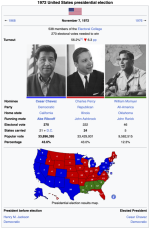
Last edited:



